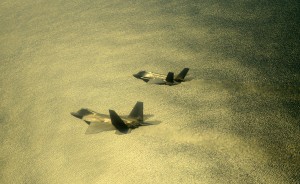2013-09-06 by Robbin Laird
In a rare moment when a designer of a policy and an implementor of the policy sit down and discuss their convergent experiences, the way ahead for the re-norming of airpower was highlighted.
On September 4, 2013, Secretary Wynne visited the 33rd Fighter Wing accompanied by myself and Ed Timperlake, and the Wing Commander, Col. Todd Canterbury graciously welcomed the Secretary and put together a core program which gave one a good sense of the pulse of the activity of the training command.
Clearly, Eglin has hit critical mass in the training effort, and this was evident from the various meetings and interviews conducted during the visit.
We will be reporting on those meetings and providing interviews where approrpriate.

But a highlight was clearly the first meeting between Secretary Wynne and Lt. Col. Berke. Secretary Wynne was a key player in shaping the F-22 billet which Lt. Col. Berke, a Marine, then filled. In the interview and in the video, Wynne laid out his thinking on why bringing another service into the F-22 was important for the joint force and the USAF itself.
Lt. Col. Berke took that billet and ran with it. He is now the F-35B squadron commander at Eglin (MAG 31). He is the only F-22 and F-35 pilot but with significant experience on F-18s, F-16s and in working with the US Army on the ground in providing air support.
Berke spoke to bringing his legacy aircraft and F-22 experience to the F-35. In the interview, he underscored that the F-18 was his plane; is his plane. But it is in another epoch.
“I am often asked to explain the differences between and F-18 and an F-16. But the comparisons are limited. The fifth generation aircraft are totally different and the pilots need significant adjustment to grasp the different operational world within which you live.
The key is to understand how the airplane operates in the battlespace and reshapes it, not just how it flies. With the 5th generation aircraft you can operate in a wide spectrum but with significant depth. You are able to operate in the full range of the electronic spectrum with both width and depth. This is not at all like legacy aircraft.
You have to understand as well, there is no data in this airplane. It provides information to the pilot and to the fleet. The data is behind the glass of the cockpit.”
In the video cut from the interview, Wynne and Berke discuss how the opportunity arose for Berke to fly the F-22 and Berke provides a clear sense of what applying that experience to the F-35 brings to the USMC and to the joint force.
Three key themes jump out.
The first point underscored by Berke in the video is the need for the pilot to alter his instincts and to think in battlespace terms and the use of information dominance as the core element of combat superiority.
The second point is the importance he sees of leveraging the F-22 experience from the USAF to do what we call “re-norming,” namely to use legacy assets differently and to take interactive con-ops between 5th generation aircraft and legacy forward.
The third point is to underscore the transformational impact which 5th generational aircraft have and will increasingly have on the joint force will fight.
The Deputy Commandant of Aviation at the time of shaping the Berke opportunity Lt. General (retired) Trautman was a key part of the transition as well.
In an interview we did last year, he went back into this period of history to review the thinking and strategic direction of the USMC leadership with regard to the F-35 and related issues in the evolution of the MAGTF and the dynamic of aviation modernization.
https://sldinfo.com/the-usmc-in-transition-the-impact-of-yuma/
Trautman added to the Wynne-Berke narrative his perspective on the transition as follows:
Secretary Wynne showed incredible wisdom and generosity when he made a precious F-22 billet available for a Marine aviator.
While the Marine Corps leadership didn’t need any prompting about the potential value of 5th generation TACAIR, we really did not fully understand just how transformational the capability would be.
Because of his diverse background, Chip Berke turned out to be the perfect choice to fulfill the opportunity he was given. His first hand experiences were invaluable in convincing the Commandant and the Marine aviation leadership that there could be no turning back.
Even in the darkest days of late 2010 when the UK unwisely bailed on F-35B, I was able to speak with confidence and certainty about the 5th generation path that we had chosen.
This was largely because of Secretary Wynne’s prescient decision and Lt. Col. Berke’s incredible performance. I will be eternally grateful to them both.
[slidepress gallery=’f-22-and-f-35-flying-at-eglin’]
These photos were shot on September 9, 2012 and are credited to Major Karen Roganov, Team Eglin PA, 33rd FW and Sgt. Jeremy Lock.
For our look at the “re-norming of airpower,” see the book of the same name:
https://sldinfo.com/defense-security-publications/
For our new book The Three Dimensional Warriors which looks at the USMC approach to combat innovation see the following:
https://sldinfo.com/three-dimensional-warriors-the-re-making-of-air-assault/


